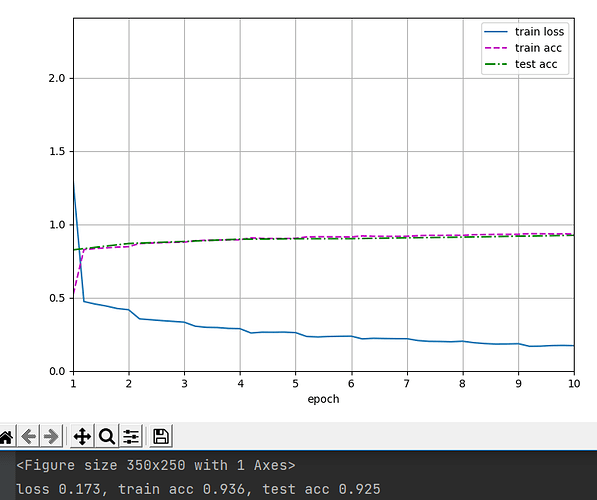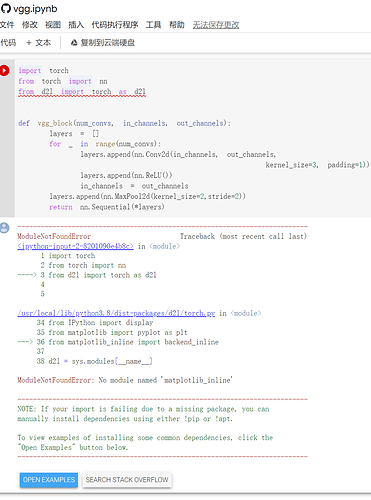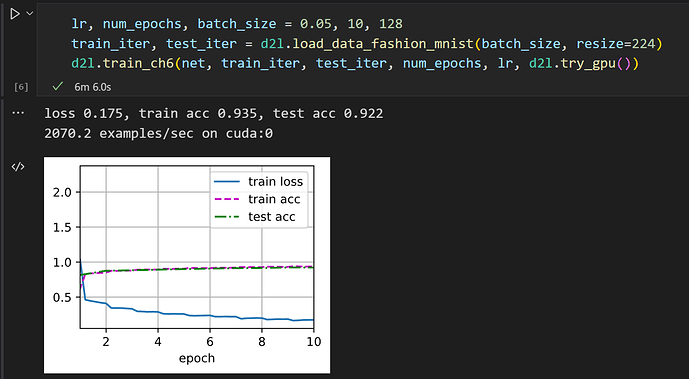第一个1 是批量数,第二个1 是通道数,通道数以及后面的高宽都是不断变化的。
问题:中文版本的pytorch Colab运行单元格报错
详细:
1.从网站主页面进入
2.点击【代码执行程序】-》【全部运行】报错:
可能的原因:
colab中d2l版本的问题
额外的尝试:
1.卸载重新安装d2l–没有解决:
!pip uninstall d2l
!pip install d2l==0.17.6
2.运行英文版本的colab是正常的,但是代码中删除了数据输出,不能直观看到每秒处理的样本数量,训练精度,测试精度。
我问chatgpt了,上面是这样回答的:
这个问题是因为Colaboratory默认情况下没有安装matplotlib-inline模块,需要手动安装才能使用。
你可以尝试以下两种方法中的任意一种:
方法一:使用魔术命令安装
在代码开头加入以下两行代码:
%matplotlib inline
!pip install matplotlib-inline
这将会安装matplotlib-inline模块,并且使用魔术命令将Matplotlib设置为内联模式,这将会使绘图直接显示在notebook中。
方法二:使用普通命令安装
在代码中加入以下一行代码:
!pip install matplotlib-inline
然后在代码开头加入以下一行代码:
import matplotlib_inline
这将会安装matplotlib-inline 模块并且导入它,你可以通过在绘图前加入以下一行代码来将Matplotlib设置为内联模式:
%matplotlib inline
用第一个方法试了,发现可以
有具体的VGG16的net吗或者他的网络架构,感谢
我的打印里可以看到11个层的结构啊,为啥习题1说只有8层?
Sequential output shape: torch.Size([1, 64, 112, 112])
Sequential output shape: torch.Size([1, 128, 56, 56])
…
Dropout output shape: torch.Size([1, 4096])
Linear output shape: torch.Size([1, 10])
这里的输出是13行,但是本质上输出的是8层神经网络。
其中Sequential5层,其中Linear3层,ReLU,Dropout这些层都不算的,因为它们不是神经元。
原始VGG网络有5个卷积块,其中前两个块各有一个卷积层,后三个块各包含两个卷积层。 第一个模块有64个输出通道,每个后续模块将输出通道数量翻倍,直到该数字达到512。由于该网络使用8个卷积层和3个全连接层,因此它通常被称为VGG-11。
我们可以得知前两个Sequential层包含了1个卷积层,后三个Sequential层包含了两个卷积层。
为什么不会输出出来呢,是因为代码不行,我们打印的代码为:
X = torch.randn(size=(1, 1, 224, 224))
for blk in net:
X = blk(X)
print(blk.__class__.__name__,'output shape:\t',X.shape)
这段代码只会打印某层的输出,不会打印子层的输出。将代码修改为如下,就可以了
X = torch.randn(size=(1, 1, 224, 224))
def print_net(net):
global X
for blk in net:
if blk.__class__.__name__ == "Sequential":
print_net(blk)
print()
else:
X = blk(X)
print(blk.__class__.__name__,'output shape:\t',X.shape)
print_net(net)
# 我的输出示例:
Conv2d output shape: torch.Size([1, 16, 224, 224])
ReLU output shape: torch.Size([1, 16, 224, 224])
MaxPool2d output shape: torch.Size([1, 16, 112, 112])
Conv2d output shape: torch.Size([1, 32, 112, 112])
ReLU output shape: torch.Size([1, 32, 112, 112])
MaxPool2d output shape: torch.Size([1, 32, 56, 56])
Conv2d output shape: torch.Size([1, 64, 56, 56])
ReLU output shape: torch.Size([1, 64, 56, 56])
Conv2d output shape: torch.Size([1, 64, 56, 56])
ReLU output shape: torch.Size([1, 64, 56, 56])
MaxPool2d output shape: torch.Size([1, 64, 28, 28])
Conv2d output shape: torch.Size([1, 128, 28, 28])
ReLU output shape: torch.Size([1, 128, 28, 28])
Conv2d output shape: torch.Size([1, 128, 28, 28])
ReLU output shape: torch.Size([1, 128, 28, 28])
MaxPool2d output shape: torch.Size([1, 128, 14, 14])
Conv2d output shape: torch.Size([1, 128, 14, 14])
ReLU output shape: torch.Size([1, 128, 14, 14])
Conv2d output shape: torch.Size([1, 128, 14, 14])
ReLU output shape: torch.Size([1, 128, 14, 14])
MaxPool2d output shape: torch.Size([1, 128, 7, 7])
Flatten output shape: torch.Size([1, 6272])
Linear output shape: torch.Size([1, 4096])
ReLU output shape: torch.Size([1, 4096])
Dropout output shape: torch.Size([1, 4096])
Linear output shape: torch.Size([1, 4096])
ReLU output shape: torch.Size([1, 4096])
Dropout output shape: torch.Size([1, 4096])
Linear output shape: torch.Size([1, 10])
其实可以从报错信息得知某个模块缺少,安装缺失的模块即可。
!pip install matplotlib_inline
!pip install matplotlib_inline 即可
nn.Linear(out_channels * 7 * 7, 4096)
为什么这里要out_channels * 7 * 7
而不是直接in_channels?
为什么我的最后结果展示不出来图(train loss/acc, test acc),只有<Figure size 350x250 with 1 Axes>

chatgpt这么秀的吗 ![]() 。。。。。。。。。。。。。。。。。
。。。。。。。。。。。。。。。。。
因为前面有一个Flatten层,所以第一个线性层的输入维度是:通道数x宽x高
我的都跑到55℃了 ![]() 字数字数字数字数字数字数字数字数字数字数字数字数
字数字数字数字数字数字数字数字数字数字数字数字数
alexnet 我最开始用cpu跑了335分钟(intel gpu没cuda),换笔记本集显4分钟跑完了,惊叹之余再一看视频课,老师半分钟就跑完了 ![]()
我之前colab忘记关会话了,免费的计算单元用光了,现在在用国内的autoDL,个人感觉还不错,可以试一试
您好,我现在直接点教材右上角的colab然后运行程序卡在第一步下载d2l要怎么解决呢





